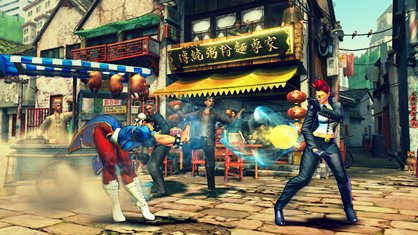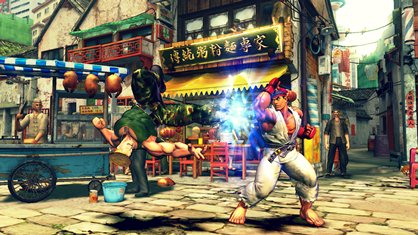Street Fighter IV - hands-on
Quarter circle forward punch! we head to Japan to go hands-on with the SF comeback
Yes, that's your chin that's twelve feet off the ground and that's our chunky fist propping it up. Sho-ryu-ken! You know what Street Fighter's all about, from the first baby steps mashing the SNES pad to the intricate magic of SF III's parry system - it's all about knocking people out of their socks. And Street Fighter IV is going to knock a hell of a lot of socks off. Oh yes.
It's taken Capcom a long time to come to SFIV (a good 10 years since SF III's debut) and the biggest question has been answered: it's a 2D fighter with 3D graphics. Of course, while other magazines simply fill in the rest of the details from the internet, we've actually played it and can put your mind at rest: it's a brilliant realisation of a superlative 2D fighter. That might seem a bit hasty, but the genius of this game is in trying to update the magic of SFII and - at this stage - succeeding admirably.

Low Jab FTW!
We played several of the classic Ken vs Ryu matches on Chun-Li's stage, and the moves and speed of the game are already there. Sweeping, throwing a fireball and the old shoryuken are all set off with the same joystick motions, and have a whole new level of 'oomph' in the crunching 3D models. It's fast as well (something the previous pseudo-3D versions never managed), and fights can turn either way in the matter of a few paltry seconds.
This is all thanks to the combo meters which come in two flavours: your super meter builds up as you pound your foe, and their revenge meter builds up as they take the pounding. Both trigger spectacular moves: one will end the fight in your favour, one will bring them right back into contention.
There's also a new 'saving' move that allows you to charge up an attack that makes you temporarily invulnerable while moving towards your opponent: it's not a great offensive weapon, but it allows approaching the other fighter without jumping, which will be a key tactical move against irritating 'fireball followed by dragon punch' players. The sweetest moments of all, however, are when you finish an opponent off and the camera zooms in and around for the best angle of your fist smacking against their crumbling solar plexus.

Might club
These may not seem like significant additions, but there's something substantial to them beyond the obvious. Street Fighter IV is setting out to level the playing field between people who just enjoy a good fighter occasionally, and people who memorise every possible button combination and spend warm weekends indoors furiously thrashing a joystick.
Wouldn't it be nice if you could surprise them with a few moves of your own, just occasionally, and land a cracking kick to the head followed by a revenge combo? That's what SFIV is all about and why, barring disasters, all the other scrappers are desperate for corners to hide in.
Sign up to the GamesRadar+ Newsletter
Weekly digests, tales from the communities you love, and more
Our playtime was confined to the shotokan boys, so we had to make sure the things we noticed were subtle ones. Like, for instance, Ken's hurricane kick not travelling as far as our man from Japan's, or the deadly mini-jumpkick of Ryu's that leaps over an attempted sweep and delivers a foot to the jaw. They even jump in different arcs. After beginning as the same character model, the difference between them now - from facial expressions and voice to their reactions when hit - is palpable, and adds hugely to the sense of one of videogame's greatest rivalries.
Some might say it's a bad thing to rely so much on an old game for your inspiration: we say they're talking rubbish... because that SFII cartridge gets more play than any number of AAA titles round our way. This is going to reignite the 2D genre that its forebear kickstarted.
Feb 12, 2008


